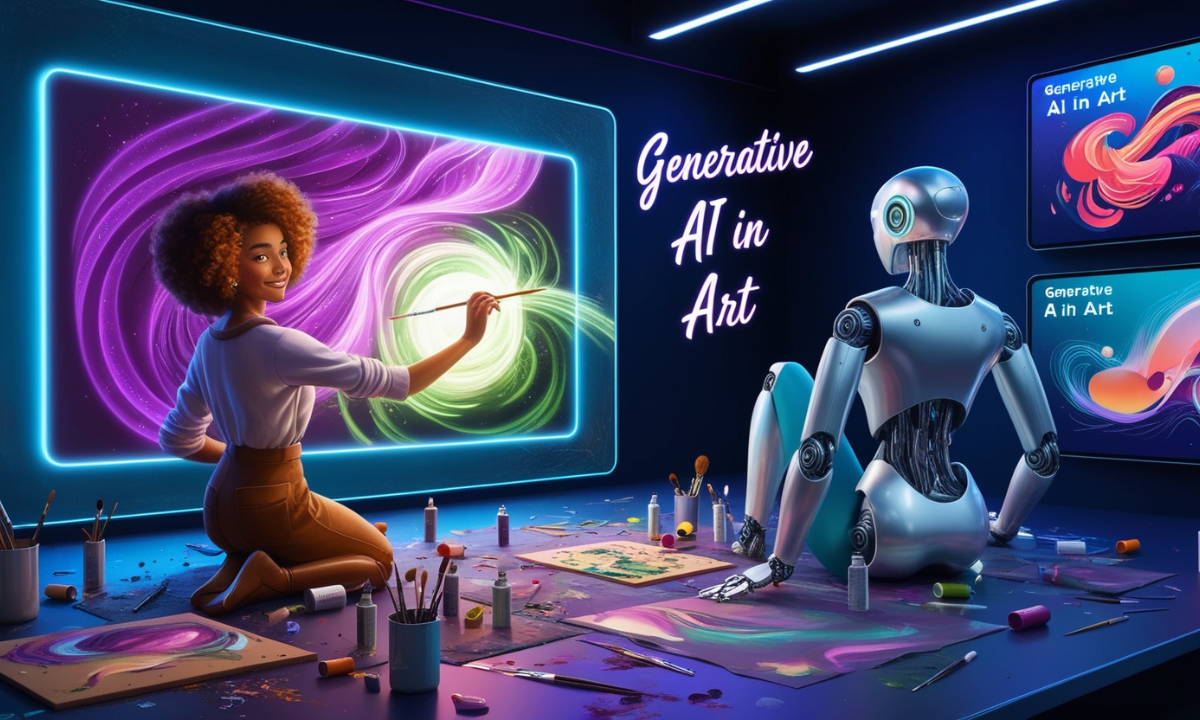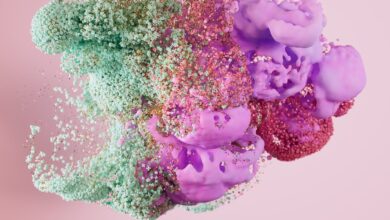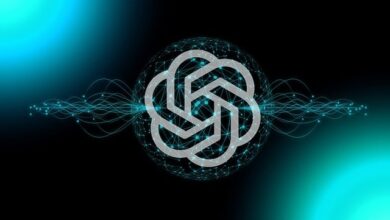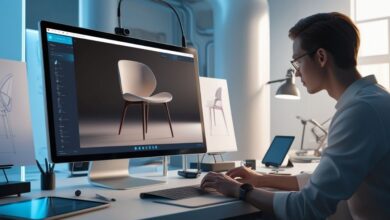
Damien Riedel AI Art, As a result of the integration between humanism and AI, we see the rise of a new type of art: AI-generated art. Well-known contemporary artists such as Damien Riedel are already at the forefront of the struggle to redefine art within this new paradigm, producing impressive and unsightly pieces in the process.
This article examines how Damien Riedel got into this field and describes the tools he works with, as well as examines the prospects for development of AI in art.
Introduction to AI Art
The Emergence of Artificial Intelligence in Art
Graphic designers have now forged a profound union between their work and technology—and so they should. Artificial Intelligence may optimize several processes in art, just as it has accomplished in medicine, marketing, and other related industries.
AI art is a subset of this expansive category, relying on generative models and various algorithms with machine learning to push the boundaries of productivity.
Earlier, artists could only depend on their imagination and skills to paint. However, thanks to Artificial Intelligence, computers can now create remarkably beautiful pictures by sifting through and learning from volumes of information.
This is made possible by the use of neural networks which are deep learning models that execute tasks in a manner similar to how the human brain operates to produce detailed and varied pieces of art.
Who Is Damien Riedel?
One individual who has made a name for himself on AI art is Damien Riedel. Riedel is largely credited with merging AI, visual and human components, and has opened doors for techniques of creating art with AI technology.
His works seek to investigate the existence of art made by machines and those made by humans, which is raises polemic about the concepts of creativity and originality in the digital age.
With the help of the Riedel generative AI, it has become possible to create wildly different unrespected artworks that incorporate a plethora of AI-assisted art techniques.
What is Generative AI in Art?
Defining Generative AI
Generative AI can be described as intelligence systems in computer systems, which seek to produce new creations and/or contents from existing creations or content .
In art, this implies that AI is able to produce artistic works such as images, music and even videos by observing and learning from various datasets such observation can have different algorithms denoting styles and themes and applying learnt patterns in its creations.
Generative models use prompts, also known as input, to generate the desired output. In most of these constructs, the use of neural networks that are Core to this Model is able to train on the input data and relate it with the output to learn the relevant styles, themes, and artistic techniques used in art.
Key Technologies in AI Art Creation
Basic knowledge essential for learning AI art has to be equipped with knowledge of technologies used in AI art creation. These include; Neural networks, Generativen adversarial networks (GANs), and Large language models (LLMs).
- Neural networks: These are computer-based programs that have been derived from the human brain and thus can draw,influence and output given some learned data.
- GANs: A GAN consists of two neural networks, one of which is responsible for producing an image while the second one judges it. Due to this back-and-forth dynamic, AI can enhance the quality of the art it produces.
- LLMs: Although they are mostly applied in the natural language domain, LLMs can be useful in AI art creation as they can provide prompts that are descriptive in nature and assist in the creative process.
Examples of Generative AI in Damien Riedel’s Work
Damien Riedel incorporates GANs and LLMs to build remarkable artistic works. By AI assisting in the creation of AI imagery, he substitutes traditional artistic techniques with computer-generated ones. Through these, Riedel is able to extend the capabilities of AI art to new levels by recreating singularity out of multiple styles.
The Technology Behind AI-Generated Art
AI Models and Neural Networks in Art Creation
The creation of art through the use of AI technology is fundamentally reliant on AI models and neural networks. They help identical analysis and learning processes to those performed by the machine, where a large dataset is employed to recognize certain patterns or styles, which can be reproduced in new works of art or adapted into something quite different.
Since AI models are built for a specific purpose which is to comprehend intricate information and create images through the use of the training that has been provided to them.
The processes and models exist in a neural framework where neural networks act as the central nervous system of the models, which operate through the organic neural tissue in the cranium.
As D. Riedel demonstrates, creating and installing such models on specific architecture makes it possible to generate “fragments” of art, intricate at a higher level than the individual author, which represents a synthesis of thinking and machinery.
Training Data and Parameters in AI Art
Any AI model training has to deal with much information retrieval. Concerning AI art, it mostly includes millions of images so that the AI might study the various styles, forms, and techniques. Then, certain parameters are provided to the model, which determines the way the output looks like.
Damien Riedel, for example, trains AI models to create art in his particular style, while still enhancing the artwork with the use of AI.
Generative Adversarial Networks (GANs)
A great advancement in terms of AI art is the generative adversarial network (GAN). It was stated earlier, within a GAN there are two opposing networks – one which produces images and another network which evaluates the output. This competition allows the AI to enhance its productions, thereby developing art that most times appears to have been made by a human.
Damien Riedel’s Journey in AI Art
Early Work and Inspirations
Damien Riedel opened up in a more traditional context; however, he did not allow himself to forget how AI can optimize and transform art as a whole. After being influenced by the works of the first AI researchers and artists, Riedel came up with ideas to use generative models in 2021 and started combining AI systems in his work.
Signature Projects and Exhibitions
Riedel has participated in numerous exhibitions in the Netherlands and the USA, where he was able to share the power of AI art with the world. One of his solo exhibits titled “Machine Dreams,” where Riedel strongly emphasized the rise of human imagination with AI graphics, took place in 2022 and should be highlighted.
Riedel’s AI Art quite often depicts stunning, fantasy-style, and surrealistic features and exquisite details made possible by GANs and deep neural networks.
Impact of AI Art on Traditional Artistic Practices
Damien Riedel succeeds in proving that Artificial Intelligence art may exist in the world of traditional art. Riedel is from those who indeed believes that AI is not something to be feared but rather a tool that has the ability to promote an artist’s work to new heights.
In his case, enabling AI tools in his practice also means that AI is a great helper of human creativity instead of its substitute.
Ethical Considerations in AI Art
Privacy, Data Protection, and Transparency
The proliferation of AI has raised new issues like those of ownership of the work and privacy obligations of the dataset creators. Since the majority of AI models today are trained using internet sources, the question is raised whether the works of artists were used without their express permission.
The ethical facets of AI art creation have also come up for Damien Riedel as for many other contemporary AI artists. Europe is relatively safe in this regard owing to the GDPR and other data regulations; however, as regards AI art, such questions are still up for debate. It is up to the AI’s trainers to make precise the amount of data which goes into making the model.
Bias and Algorithmic Challenges
Apart from these concerns, AI art also begs the question of algorithmic fairness as well. This is because AI models are data-driven and can be trained on datasets with bias.
For example, if an AI model is largely trained with Western art, only Western art assists the generation process within the model.
This is conversely the problem which Damien Riedel seeks to eradicate for himself by claiming that diverse training datasets containing a wide range of cultures and styles have been used to create his art works.
Intellectual Property and Ownership of AI-Generated Art
Arguably, one hot topic under artificial intelligence art creation is copyright, more specifically, who owns the art that a machine produces? For example, is it the person producing the AI, is it the AI itself, or are the authors of the training data the relevant stakeholders?
Damien Riedel practice quite a flexible approach, arguing that just like other creative tools, AI is simply a tool of the artist, and the artist owns the artwork they create. However, he suggests that a concrete framework for the usage of AI-generated art is a necessity.
The Future of AI Art
Advancements in AI Technology for Art
In Riedel’s opinion, demand and supply of such innovative technology will undoubtedly grow over time, and AI-generated art will become the new standard. AI tools, including Chatgpt and many other models, showcase the ever-evolving field of AI art generation.
Riedel forthrightly states that as technology continues to improve, the integration of AI within the creative processes of a variety of industries will expand.
Technologies in the future, for example, foundation models. These models consist of billions of parameters and have the potential to revolutionize the field of AI, allowing for much greater artistic expression and creative work than ever before.
AI as a Tool for Enhancing Human Creativity
And instead of being the perspective of artists’ replacement, Damien Riedel focuses on using AI to enlarge the creativity of human beings. With AI, artists are able to play around with a myriad of forms, styles, and techniques that would be impractical or almost impossible to do manually.
Economic Impact of AI Art on the Art Market
AI-generative art is gaining more traction and is even starting to cause a stir in the art market. Some artistic pieces created by Ai are selling at a fairly high price, leading to more galleries and collectors’ interest. Some of Damien Riedel’s AI-generated works have been attracting collectors and raising questions over future AI art value.
AI-generated art is quickly gaining a following, and it is fair to say that AI can have a great impact on the art world. This will expand avenues for artists to create and how they get paid for their art.
Damien Riedel’s Legacy in AI Art
The Intersection of Art, Technology, and Society
In the works of Damien Riedel, one can see the increasing relationship between art and technology in the contemporary society. He crossed the traditional art borders, creating a participative creative process with the use of AI based tools and techniques.
Key Contributions to the AI Art Movement
Back to the origins of AI art, in a wide sense, this was the goal set by Riedel. He popularized the exploration of areas within creative fields for which generative models, GANs and deep neural networks can be applied.
Damien Riedel’s Continuing Impact
When looking towards the future, Damien Riedel doesn’t seem like the type to rest on his laurels. With the progress of AI technologies, he’s hopeful about delving into even more global initiatives, thus expanding what AI-generated art covers. His realizations will surely motivate many other artists and people engaged with technology.
My Opinion
To sum up, the practice of Damien Riedel, Robert Lentz and other artists with a similar practice are perfect examples of the application of artificial intelligence practically in a complex and artistic way.
Riedel has proven how this blend of AI technology with other tools can do wonders due to its generative aspect to the art creation process. To the extent that the future offers many opportunities for AI-generated art, we are ready to enter a new era where imagination and machines will unite.






